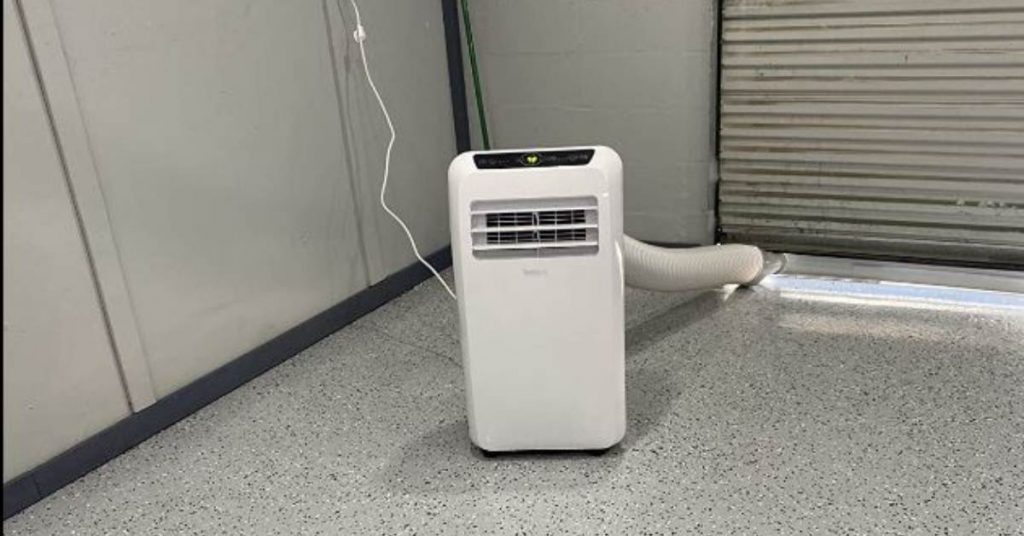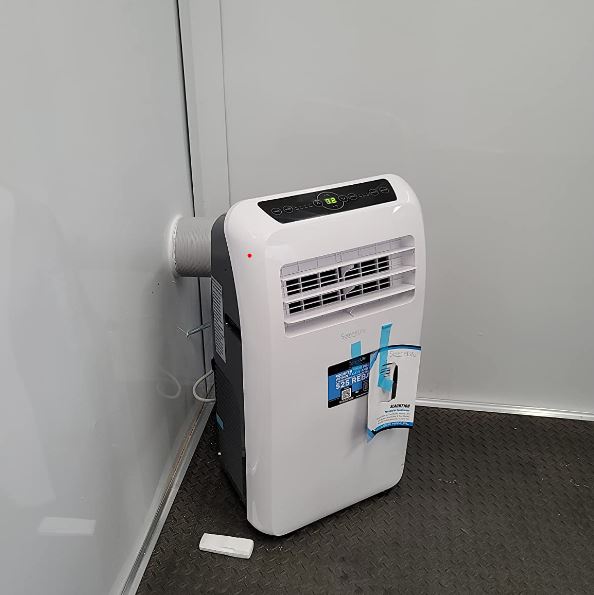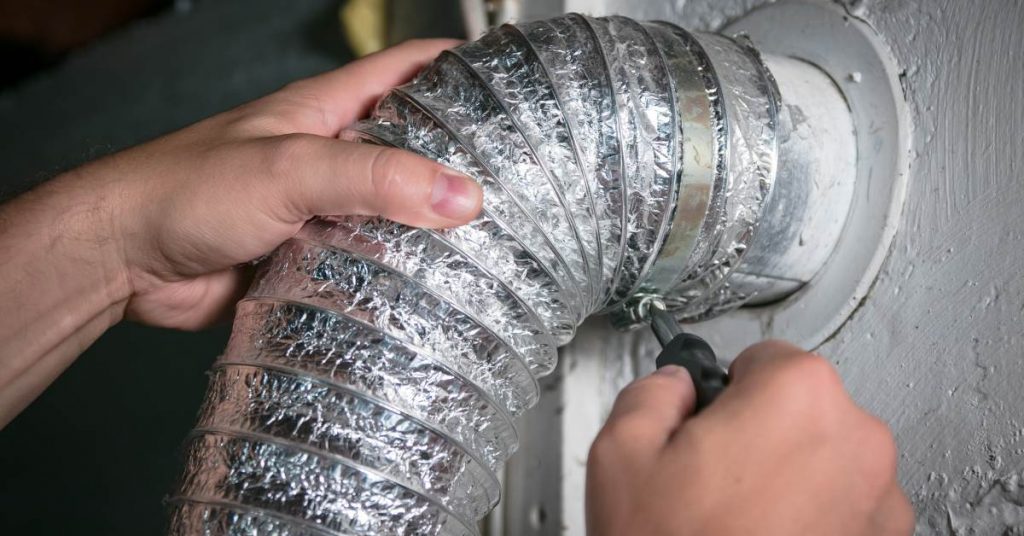Can Portable Air Conditioners Be Used in a Room without a Window?
Although we call them portable air conditioners, they are not as portable as say dehumidifiers since they need to be vented to the outside. Without venting, a portable air conditioner can even make the indoor air hotter that it originally was.
Air conditioners remove heat from the indoor air but need to release it outside. Portable air conditioners therefore need to be vented in order to remove the heat otherwise the hot air will keep circulating indoors.

This problem is always with portable air conditioners since other types of air conditioners have an indoor and outside unit. While the indoor unit is cooling the air, the outside unit is responsible for releasing the heat to the surrounding.
So, how can you vent a portable air conditioner without a window? Can a portable air conditioner even be used in a room without a window?
There are 5 main ways to vent a portable air conditioner without a window. You can vent a portable AC through the wall, door, ceiling, dryer vent or through the chimney. Each method has its shortcomings so choose the most convenient one for your home.
But must portable AC be vented? What would happen if you don’t vent a portable air conditioner?
If you don’t vent a portable air conditioner, the hot air from the unit will have nowhere to go. Instead, the indoor air will keep going through a cooling and heating cycle which will be very expensive since the unit will be forced to keep running, consuming more electricity.
If you want to use a portable air conditioner without a vent, you should set it to the “dehumidifier” mode. Although it will not cool the air, it will reduce humidity in the house which will make the indoors a little comfortable.
Also, a portable AC has to be vented outside, unless you are running it purely on the dehumidifier mode. Failing to vent a portable AC or venting it to another room means that it will be circulating the same air between cool and hot cycles or transferring hot air from one room to another
How to Vent a Portable Air Conditioner without a Window
As I have mentioned, there are 5 great ways you can use to vent a portable air conditioners without a window. Some may work for you while others may not.
Houses are designed and built differently. While it may be easy for a portable AC in a certain house to be vented through the door, in another house such a method may be impossible.
It is therefore important for you to carefully think of where you want to install the air conditioner and the best method to vent it. Let us look at all the five methods in more details.
The following are the 5 ways to vent a portable air conditioner without a window:
1. Venting a Portable AC through the Door

Venting a portable air conditioner through the door is one of the most common ways of venting a portable air conditioners without using a window. It works well if you have a sliding door and that is why this method is great especially in you are installing the AC in bedroom, living room or office with an outside sitting area.
Before deciding to move on with this method, you have to ask yourself one critical question, “Where does this door lead to”?
If the doors leads outside or to balcony, this method will be a perfect pick. However, if the door leads to another room or a hallway then you may need to reconsider.
The main reasons why sliding doors are the best ways to vent a portable AC is that they always lead to the outdoors and there are kits to install and vent portable AC through the doors. The kits can fit any size of sliding door.
One disadvantage of this method is that you will be forced to have the portable AC unit very close to the door since the exhaust hoses are usually not that long.
If you are own a pet and have a pet door in the room where you want to have the AC, you can decide to curtail your pet’s movements for your comfort. Venting a portable air conditioner through the pet door is a great way to keep your room cool.
To prevent hot and humid air from entering the room (and hence reducing your AC’s efficiency), you will also need to seal the area around the exhaust hose. This method also allows you to keep the portable AC away from the main door.
2. Venting a Portable AC through the Wall.

If you can manage to drill a hole, through your wall, you can easily vent a portable air conditioner to the outside. I like this method because it works perfectly most of the times, unless you are renting and you are not allowed to drill a hole through the wall.
Although the room will have 4 walls, it is important to make sure that you are drilling the hole in a wall that will vent your AC to the outside. This may sound like an obvious statement but I have seen folks make the mistake of drilling a hole that leads to another room.
You will need to consider that your walls are made of before starting to drill the hole. It is easy to drill a hole through a dry wall or one made of timber but definitely very hard if the wall is made of stones and concrete.
Also, do you know where key installations in your house like plumbing and electrical conduits go through in the walls? You definitely don’t want to hit a water pipe or electrical wire while drilling through the wall.
This analysis also helps you to make sure that you have right tools for the job. Drilling a hole through a drywall and drilling another through concrete will need different set of tools.
You also need to drill a hole in such way that you don’t weaken or compromise the structural integrity of the house by say drilling through the beams or studs. Drill your hole through a safe spot on the wall.
If you wish to buy a dual-hose portable air conditioner, you may not favor this method since that also means drilling 2 holes through the wall. However, a single-hose portable AC will be perfect for this method.
You should make sure that you drill a hole of the same size as the AC unit’s exhaust hose. After venting the Unit through the wall, seal all around the exhaust hose to keep insects from entering the house and to also increase the unit’s efficiency.
If you are not sure if you can safely drill the hole yourself, you can hire a handyman or professional HVAC technician to do it for you.
3. Venting a Portable AC through the Ceiling

This method is mainly used to vent portable air conditioners in offices or computer rooms that don’t have windows. However, you will need to have a drop ceiling in order to vent your AC through this method.
The main reason this method is not common in most homes is that drop ceilings are no longer used in modern housing. However, if you have an old house with a drop ceiling then you can definitely vent your portable AC through it.
Just like with venting an AC through the wall, you will also need to make a hole through a ceiling tile and after running the exhaust hose through it seal all around it to keep away the hot and humid air.
Venting a portable air conditioner through the ceiling as described above is not something most homeowners can do on their own. Luckily, there are universal portable AC ceiling installation kits which you can use to do exactly that.
One of the main disadvantage of this method in my opinion is that it can really compromise the aesthetics of the room. The exhaust hose runs vertically from the unit through the ceiling, meaning that it is quite conspicuous and not appealing to look at.
4. Venting a Portable Air Conditioner through the Dryer Vent

It is possible to vent a portable air conditioner through the dryer vent though it comes with a few risks and that is why manufacturers and some HVAC professionals don’t recommend it.
One reason why this method is problematic is that the dryer vent is of a smaller diameter compared to a portable AC’s vent and you will therefore need to use a lot of force to push it through. But that is not all.
Portable AC exhaust hoses are short in size but big in dimeter for a reason. Connecting it to the dryer vent may results in problems after sometime, mainly due to poor efficiency and also its ability to exhaust hot air.
There is also the likelihood of the heat building up in the system resulting in a fire. That is why you need to make sure that the dryer vent is actually exhausting the hot air after venting the AC through it.
Also, most of the rooms where you would want a portable AC installed are usually quite far from the dryer vent. Although you can buy an extension hose, aesthetics and efficiency are things you will also need to think about.
There are many homeowners who have vented their portable air conditioners through the dryer vent without issues. I just felt that I needed to let you know of the few limitations and what may happen if the installation is not done properly.
5. Venting a Portable AC through a Chimney

This method is not applicable to most people for the following reasons:
- You need to have a chimney in the first place.
- You need not use the chimney. Why have a chimney if you can’t use it?
- Pushing the exhaust hose through the ceiling is not easy.
- You need a long exhaust hose; as long as the length of the chimney.
If you can overcome the above challenges, venting your portable AC through the chimney can be a great way of keeping your house cooling and without drilling holes on the wall.
Wrap Up
Portable air conditioners are inexpensive, easy to move around and one of the best ways of cooling small spaces. Venting them is however the greatest challenge. It is also what makes them the least energy-efficient air conditioners.
It is even a big challenge to vent them unless you have a sliding door or you can easily drill a hole through the wall. You just need to be smart about it.
I know folks who have vented their portable air conditioners through the central HVAC return air duct, heating vents or bathroom exhaust vents. You just need to think of a way to remove the air from the unit to the outside.
